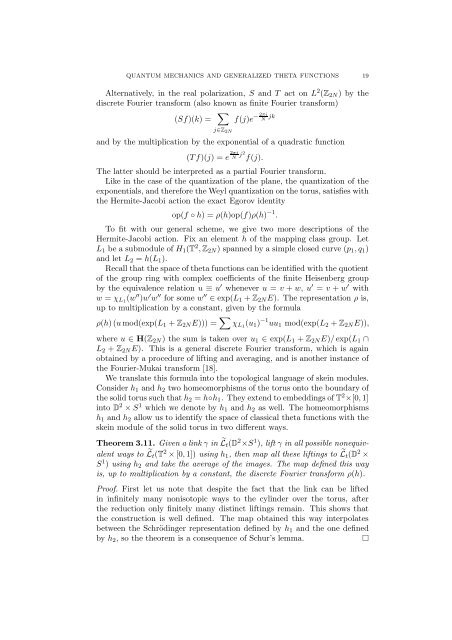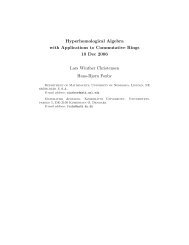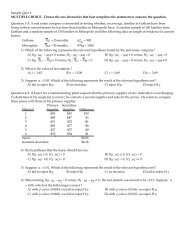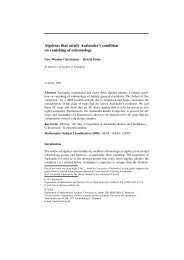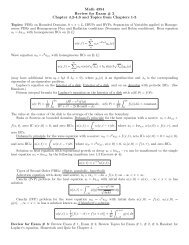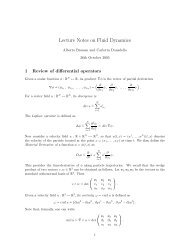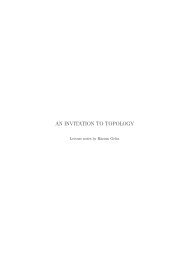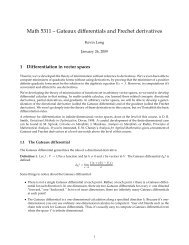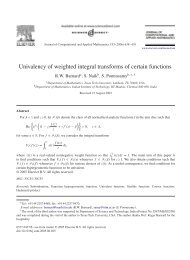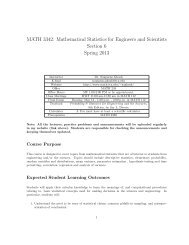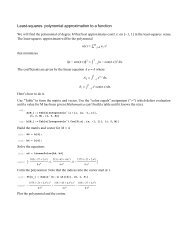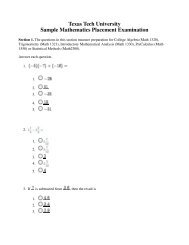QUANTUM MECHANICS AND NON-ABELIAN THETA FUNCTIONS ...
QUANTUM MECHANICS AND NON-ABELIAN THETA FUNCTIONS ...
QUANTUM MECHANICS AND NON-ABELIAN THETA FUNCTIONS ...
You also want an ePaper? Increase the reach of your titles
YUMPU automatically turns print PDFs into web optimized ePapers that Google loves.
<strong>QUANTUM</strong> <strong>MECHANICS</strong> <strong>AND</strong> GENERALIZED <strong>THETA</strong> <strong>FUNCTIONS</strong> 19Alternatively, in the real polarization, S and T act on L 2 (Z 2N ) by thediscrete Fourier transform (also known as finite Fourier transform)(Sf)(k) = ∑f(j)e −2πi N jkj∈Z 2Nand by the multiplication by the exponential of a quadratic function(Tf)(j) = e 2πiN j2 f(j).The latter should be interpreted as a partial Fourier transform.Like in the case of the quantization of the plane, the quantization of theexponentials, and therefore the Weyl quantization on the torus, satisfies withthe Hermite-Jacobi action the exact Egorov identityop(f ◦ h) = ρ(h)op(f)ρ(h) −1 .To fit with our general scheme, we give two more descriptions of theHermite-Jacobi action. Fix an element h of the mapping class group. LetL 1 be a submodule of H 1 (T 2 , Z 2N ) spanned by a simple closed curve (p 1 ,q 1 )and let L 2 = h(L 1 ).Recall that the space of theta functions can be identified with the quotientof the group ring with complex coefficients of the finite Heisenberg groupby the equivalence relation u ≡ u ′ whenever u = v + w, u ′ = v + w ′ withw = χ L1 (w ′′ )w ′ w ′′ for some w ′′ ∈ exp(L 1 + Z 2N E). The representation ρ is,up to multiplication by a constant, given by the formulaρ(h)(umod(exp(L 1 + Z 2N E))) = ∑ χ L1 (u 1 ) −1 uu 1 mod(exp(L 2 + Z 2N E)),where u ∈ H(Z 2N ) the sum is taken over u 1 ∈ exp(L 1 + Z 2N E)/exp(L 1 ∩L 2 + Z 2N E). This is a general discrete Fourier transform, which is againobtained by a procedure of lifting and averaging, and is another instance ofthe Fourier-Mukai transform [18].We translate this formula into the topological language of skein modules.Consider h 1 and h 2 two homeomorphisms of the torus onto the boundary ofthe solid torus such that h 2 = h◦h 1 . They extend to embeddings of T 2 ×[0,1]into D 2 × S 1 which we denote by h 1 and h 2 as well. The homeomorphismsh 1 and h 2 allow us to identify the space of classical theta functions with theskein module of the solid torus in two different ways.Theorem 3.11. Given a link γ in ˜L t (D 2 ×S 1 ), lift γ in all possible nonequivalentways to ˜L t (T 2 × [0,1]) using h 1 , then map all these liftings to ˜L t (D 2 ×S 1 ) using h 2 and take the average of the images. The map defined this wayis, up to multiplication by a constant, the discrete Fourier transform ρ(h).Proof. First let us note that despite the fact that the link can be liftedin infinitely many nonisotopic ways to the cylinder over the torus, afterthe reduction only finitely many distinct liftings remain. This shows thatthe construction is well defined. The map obtained this way interpolatesbetween the Schrödinger representation defined by h 1 and the one definedby h 2 , so the theorem is a consequence of Schur’s lemma.□


